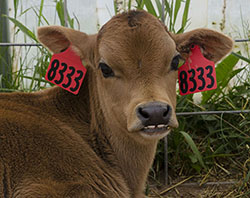 We've been indoctrinated with the five C's to give calves their best possible start. Colostrum tops this list, followed by calories, cleanliness, comfort and consistency. Despite the order we've all been taught, colostrum and cleanliness must go hand in hand.
We've been indoctrinated with the five C's to give calves their best possible start. Colostrum tops this list, followed by calories, cleanliness, comfort and consistency. Despite the order we've all been taught, colostrum and cleanliness must go hand in hand.Even colostrum feeding has its own mantra, noted Bob James in a recent Dairy Pipeline.
- We must feed high-quality colostrum. Levels exceeding 50 grams of IgG per liter are considered good. On a Brix refractometer, values exceeding 22 indicates good quality colostrum.
- Feed enough colostrum and feed it early. It is often recommended that the calf receive 4 liters of colostrum in the 12 hours after birth. This provides approximately 200 grams of IgG.
- It must be CLEAN!
Excessive bacterial levels often arise from two sources: the calving environment and poorly handled colostrum.
As it comes from the cow, noted James, first-milking colostrum has a relatively low bacteria count (less than 100 colony forming units per milliliter). Research from the University of Minnesota has found that, on average, the bacterial counts obtained from an esophageal feeder or storage bucket exceeded 10,000 cfu/mL.
Any tool we use to store or provide colostrum to the calf must be rigorously sanitized. After each use, James recommends the following sanitation steps:
- Rinse with lukewarm water
- Scrub with hot, soapy water
- Rinse with a sanitizer
- Invert to allow drying
Another Minnesota study demonstrated the importance of maintaining low bacterial levels in colostrum. In a field trial, 500 calves were fed raw colostrum while the other half received pasteurized colostrum. The high level of coliform bacteria in the raw colostrum was highly and negatively correlated with antibody absorption.
 The author, Amanda Smith, was an associate editor and an animal science graduate of Cornell University. Smith covered feeding, milk quality and headed up the World Dairy Expo Supplement. She grew up on a Medina, N.Y., dairy, and interned at a 1,700-cow western New York dairy, a large New York calf and heifer farm, and studied in New Zealand for one semester.
The author, Amanda Smith, was an associate editor and an animal science graduate of Cornell University. Smith covered feeding, milk quality and headed up the World Dairy Expo Supplement. She grew up on a Medina, N.Y., dairy, and interned at a 1,700-cow western New York dairy, a large New York calf and heifer farm, and studied in New Zealand for one semester.








